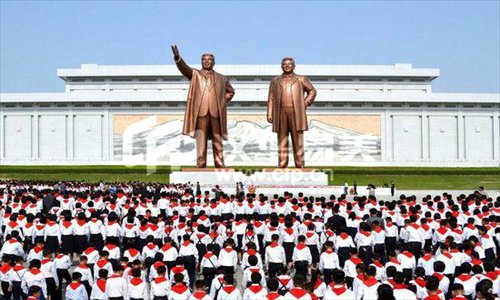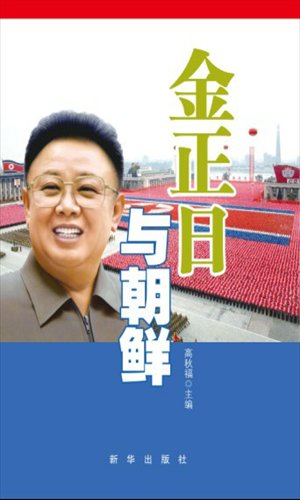'Kim Jong-il and North Korea'


Book reveals subtle changes about the secret state
Many people seem to have endless questions about what the "real" North Korea is like, beneath its secluded presence in the international community. Released in early July, the book Kim Jong-il and North Korea attempts to unveil this mysterious country through words.
This is the first book in the Chinese mainland to comprehensively introduce North Korea during the reign of Kim Jong-il and the first to feature him on the cover. The book is a collection of reports gathered from several Xinhua News Agency journalists stationed at Pyongyang, the capital of North Korea. Most of the reports are about recent events.
"I report what I see, and through interviews with local people, those reports can reflect an authentic side of the country," said Gao Haorong, the main contributor of the book.
Stationed at Pyongyang for 15 years, Gao's reports cover a wide range of topics from the political and social life, to local customs and art.
"We have distributed nearly 10,000 books since it was published," said the copy editor of Kim Jong-il and North Korea who is surnamed Liu.
"Readers have called asking for more information about the book."
Front line view
Currently, six foreign media organizations from four countries have resident offices in Pyongyang. Three are China-based: Xinhua, CCTV (China Central Television) and People's Daily. The other three are ITAR-TASS from Russia, Kyodo News from Japan, and The Associated Press (AP) from the US. The AP set up its branch in January this year.
Kyodo News and the AP do not have resident correspondents but hire local reporters instead.
"The foreign media in Pyongyang receive equal treatment," Gao told the Global Times.
He said that Xinhua enjoys a close relationship with local departments since it established the bureau in Pyongyang in the late 1940s, developing mutual trust over the years.
"The articles in the book are original reports without cuts or revisions," said Liu."It records local events that reporters have witnessed, different from perhaps distorted reports from other media organizations."
For example, the book states that mobile phones are popular; the country has a widespread 3G network.
"They are not so isolated from modernity, as many reports state," said Liu.
"China doesn't have a single book about North Korea since 1949, not even a translated one, in light of the sensitive and complex topics around the country. There are few channels to gain information," he told the Global Times.
But since the regulation of media in North Korea is strict - interview requests by foreign media organizations must be approved by local authority - there are situations where interviews can't dig deeper, according to Gao.
"The reports are objective and reflect what I saw," he said.
Multifaceted nation
Politics undoubtedly occupies a major part of North Korean life. The book provides examples about the people's respect for former leader Kim Jong-il.
February 16, Kim Jong-il's birthday, is one of the nation's biggest festivals, accompanied by various celebrations. Food and flower bouquets line the streets, along with singing and dancing performances. Lectures talk of the leader's contributions to the country.
On a daily level, complimentary phrases are plastered everywhere, like "peerless great man," and "No. 1 general under heaven." Slogans and posters are found on streets, railway stations, classrooms, and work offices. They advocate the achievements of the leaders.
Some aspects of society that foreigners might gloss over are also addressed, such as North Korea's night life, which is depicted as open and lively, though lacking in clubs and bars.
Parks have always been favorite areas for local residents to spend time after dinner. From 7 pm to midnight, families and children enjoy entertainment facilities like rollercoaster and go-karting at Kaeson Youth Park in Pyongyang. Elderly citizens rest after work.
Foreign presence in the park has increased in recent years since its opening in 2010, with parks becoming a popular place for foreigners to spend their night.
Besides the park, going to karaoke and drinking beer are rising as night time options.
Changing times
One of the few foreign resident correspondents in Pyongyang, Gao experienced many changes in the city.
But there are many long-lasting traditions that have impressed Gao the most, such as the nation's political life.
On holidays, people present bouquets of flowers to the bronze statue of Kim Il-sung, the founder of the country and father of Kim Jong-il, in Mansudae. Activities start from morning and last until midnight, with throngs of people, seas of flowers, and images of Kim Il-sung spread across the country.
Meanwhile, the country's economic focus remains unchanging. Priorities are on the heavy industry and defense industry, as before.
Some changes are the increase in restaurants and the appearance of large-scale commodity markets.
"Foreigners were once forbidden to enter markets, but now they can buy things at markets appointed by the government," said Gao. Some places even have parking lots reserved for foreigners.
"'The book is a way for the international community to learn more about North Korea," said Fang Xiuyu, an expert in Korean Studies at Fudan University.
"We have limited knowledge about the real North Korea."